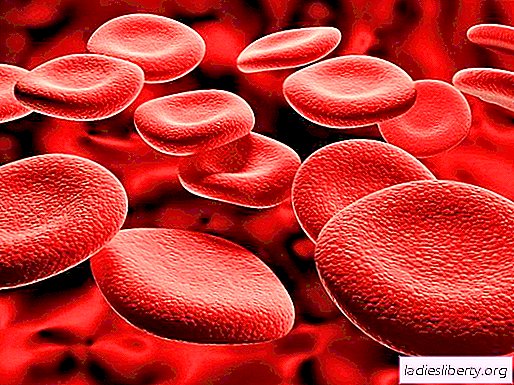
The trigeminal nerve consists of three branches that lie above the eyebrows, on both sides of the nose and in the area of the lower jaw.
Its task is to control the neurological condition of the face.
Consider in more detail the causes of trigeminal inflammation (neuralgia) and methods of treating this unpleasant condition at home.
Trigeminal inflammation: causes
To date, there is no exact cause of inflammation of the trigeminal nerve, however, doctors identify such factors that can contribute to the development of this disease:
1. Strong hypothermia. At the same time, neuralgia can cause not only a stay in the wind and frost, but also a simple wash with cold water.
2. A trauma to the face (a fall, a blunt blow, a bruise, etc.) can trigger the inflammation process and, as a result, the development of neuralgia.
3. A disease such as vascular aneurysm or oncological pathology can squeeze nerves, causing their inflammation.
4. Various diseases of the oral cavity can easily provoke a further spread of infection in the face. Typically, these diseases are pulpitis, periodontitis and sinus diseases.
5. Meningitis.
6. Violation of the bite of the teeth can distort and squeeze the nerves, making them more vulnerable to inflammation.
7. Multiple sclerosis, which is not treated.
8. The acute form of herpes.
9. Concussion.
10. Various acute viral or bacterial diseases.
11. Acute respiratory infections.
12. metabolic disorders in the body.
In addition, an attack of acute neuralgia can sometimes occur accomplished spontaneously (when a person laughs, shaves, washed or just talks).
In most cases, this disease affects people between the ages of fifty and sixty who have problems with blood vessels and heart.
Trigeminal inflammation: symptoms and signs
The following symptoms of trigeminal inflammation are distinguished:
1. Pain is the most distinctive sign of this disease. It will be localized in the lower jaw, and give to the whole face, eyes, neck.
The pain will intensify when talking, hypothermia or eating. It can not be removed with conventional painkillers.
In addition, pain in neuralgia is divided into two separate types: typical and atypical.
With typical pain the person will have a wave-like pain syndrome (the pain will aggravate, then subside again). The nature of such pain is sharp, shooting, throbbing, burning. The frequency of manifestation is different (in some patients, pain occurs every hour, in others it can occur only several times a day).
Atypical pain observed less frequently. Her character is aching. It can flow monotonously for several hours. It is this type of pain that is more difficult to treat.
2. Redness and swelling of the eyelids.
3. Tearing.
4. Increased salivation.
5. Involuntary contraction of the muscles of the face.
6. Loss of facial skin sensitivity.
7. Violation of taste.
8. Weakness.
9. Sleep disturbance.
10. Muscle spasms.
11. Anxiety of the patient in expectation of new attacks of pain.
12. The appearance of asymmetry of the face due to distortion of the muscles.
13. The appearance of sharp outbreaks (shootings) of pain, which is similar to an electric shock.
14. Increasing facial sensitivity.
15. Numbness of the nose and cheeks.
16. An increase in body temperature.
17. The appearance of a rash in the affected part of the face.
18. Headaches.
19. Weakness.
20. Chills.
It is important to know, that inflammation of the trigeminal nerve has a progressive course, and if you do not eliminate it in time, then most of the symptoms may not go away even after further therapy. This means that from time to time a person can still be bothered by severe pain attacks, numbness of the face and muscle tremors.
Besides, trigeminal neuralgia is very similar in its symptoms to occipital neuralgia and Ernest syndrome.
For this reason, it is worth being extremely careful in the diagnosis and accurately identify the root cause of the disease. This will greatly simplify the treatment process and help the doctor choose the right drugs.
If you do not conduct timely treatment of this type of neuralgia, then it can cause such complications in the patient's condition:
1. Hearing impairment.
2. Violation of taste.
3. Chronic pain.
4. Paresis of the facial muscles.
5. Atrophy of the facial muscles.
6. Damage to the nervous system.
7. Deterioration in the central nervous system (patient isolation due to constant pain).
8. Sleep disturbance.
Trigeminal inflammation: home treatment
One of the most effective home remedies for neuralgia is massage. Its main objective is the rapid removal of pain in the patient and the relaxation of muscle tension in the affected muscle groups.
In addition, with the help of massage you can improve blood circulation, relieve inflammation and swelling from the face. The technique of this procedure is simple: the patient needs to sit down and put his head on the headrest so that the muscles of his face relax.
After this, you should begin to make light circular movements in the face in the area of affected muscle groups. Gradually, it is necessary to increase the pressure and stroking movements. The time of the procedure should be no more than twenty minutes. Repeat it preferably twice a day for two weeks.
During the massage, moisturizers and oils can also be applied to the face to improve the elasticity of the tissues.
Another effective treatment for neuralgia at home is the use of alcohol blockade. They have a pronounced analgesic and antispasmodic effect. To prepare them, you need to use 80% alcohol solution and novocaine.
Despite this, these blockades have a risk of bleeding, so it is still advisable to carry them out in a hospital under medical supervision.
In order not to cause any complications, you should be aware of such procedures that can not be done with inflammation of the trigeminal nerve:
1. You can not warm your face with heaters and apply warm compresses for a long time, as this will only increase swelling and inflammation.
2. You can not put ice on your face for a long time, since this can further worsen the sensitivity of the skin and impair blood circulation.
3. It is not advisable to take any medications without a doctor’s prescription. Moreover, it is strictly forbidden to inject drugs without the prior permission of the doctor.
Features of the treatment of trigeminal inflammation at home
The fastest recipes for an attack of facial neuralgia are:
1. Means of fir oil. It must be diluted with olive oil in a ratio of 1: 5 and rubbed into the skin for three days in a row.
2. A recipe for chamomile. For this you need 1 liter of boiling water to fill 1 tbsp. l dry pharmacy chamomile and insist for an hour. The finished solution should be put into the mouth and held there for at least five minutes. The tool will help relieve swelling, pain and inflammation.
3. Fry the buckwheat in a pan and pour it warm into a cloth bag. Apply to face for ten minutes every day. It is important to know that such a procedure can only be done at the initial stages of the course of the disease, when it is not yet very running.
4. Wipe the skin with juice from black radish twice a day.
5. Apply a compress of honey and fresh cabbage leaves on the face at night. The tool will help relieve swelling and severe pain.
6. Wipe your face with small ice cubes after each bout of pain. In this case, it is advisable to massage the face with warm hands after this procedure.
7. Rub your face with a mixture of vodka and almond oil. It will help relieve pain and acute inflammation.
8. Mix vinegar and white cosmetic clay and make thin layers from the finished mixture. Apply them to your face for three days.
9. Grind several dates and mix them with milk. Ready mass to eat a tablespoon for a week. The tool will help relieve muscle paralysis.
Before using traditional medicine, you should always consult your doctor.
If, however, a week after the development of symptoms of neuralgia, a person’s condition does not improve, then doctors recommend starting traditional drug therapy, which involves taking painkillers, antispasmodics, and drugs to improve the functioning of the human nervous system.











